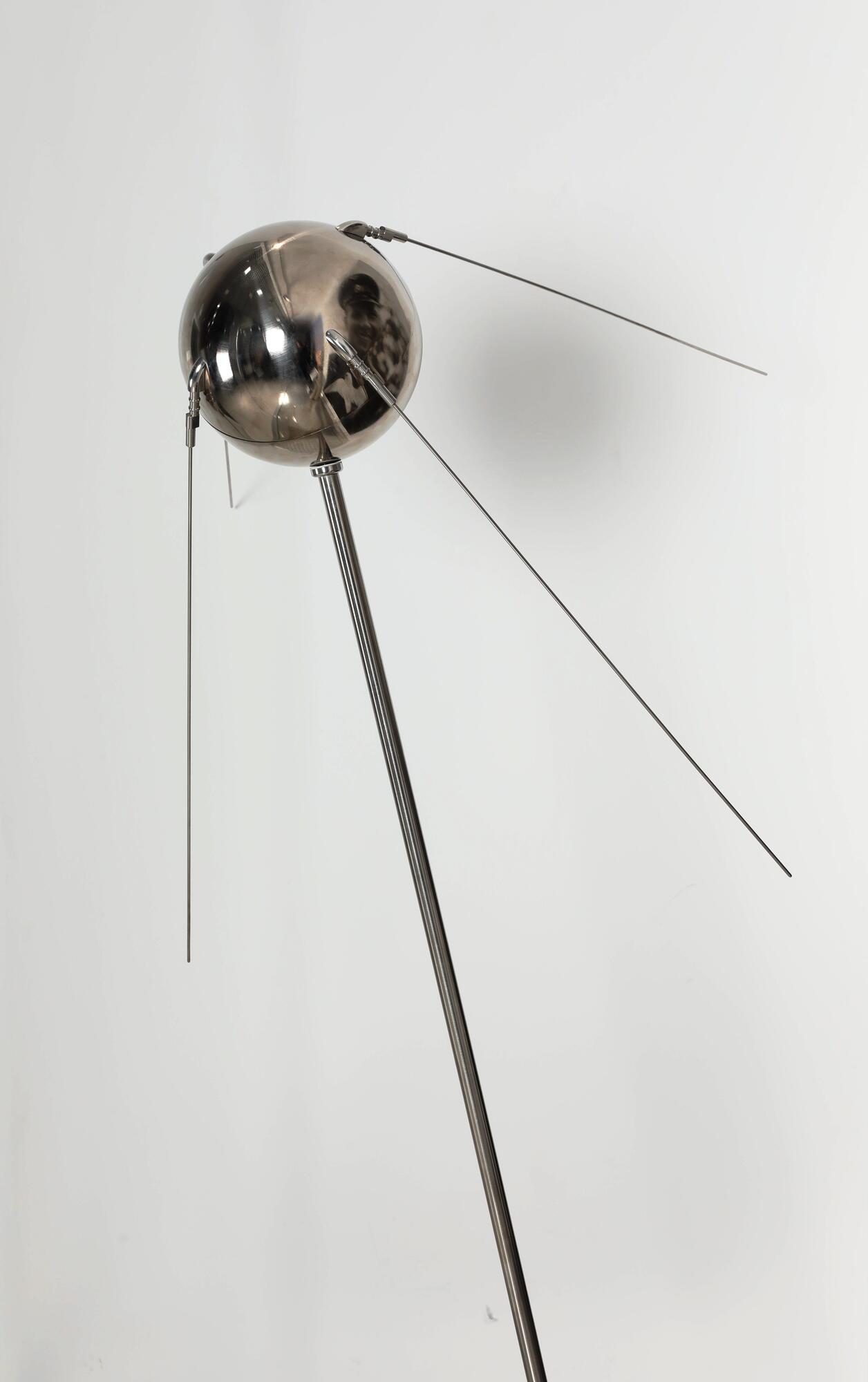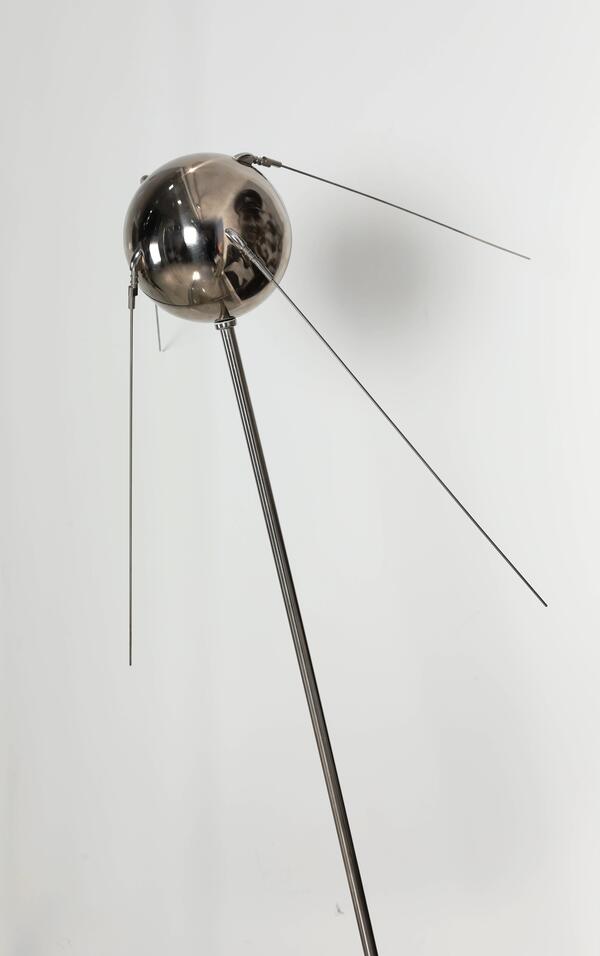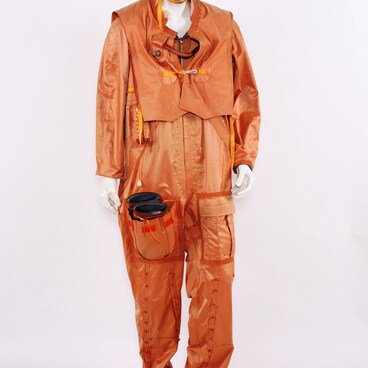Model of the first artificial satellite of the Earth, scale 1:2.5. Made especially for the opening of the Museum of Cosmonautics by the Avitekh factory, Kirov.
The first artificial satellite of the Earth had a spherical body and four long antennae for sending signals. The body was 58 cm in diameter, and its antennae were 2.4 and 2.9 meters long. It weighed 83.6 kg. Inside the satellite was a radio transmitter powered by silver zinc batteries, temperature and pressure sensors, a thermostat to ensure a constant temperature, and a ventilator.
The satellite was launched from Baikonur cosmodrome on October 4, 1957 at 22.28 Moscow time. The booster rocket that took the satellite into orbit was also called Sputnik, and was a modification of the R-7 military intercontinental ballistic rocket. Developed by a team of designers headed by Sergey Pavlovich Korolyov, the rocket was 29 meters high and weighed 267 tons.
Having considered a number of different satellite designs, Korolyov’s team opted for the simplest one. In the project documentation, it is referred to by the code name PS-1 (“Prosteyshy Sputnik”, or “Simplest Satellite”). One important factor when choosing the satellite design was the “Space Race” — the rivalry between the USSR and the USA to carry out missions in space. PS-1 had an ideological as well as a technical mission. Its launch contributed to the USSR’s prestige as a leading scientific power. The first American satellite, Explorer 1, was successfully launched into orbit only on February 1, 1958.
PS-1was the first man-made object in history to reach orbital speed, which is 7.9 km/hour. velocity. It followed an elliptical orbit, at between 947 km (max) and 288 km (min) from the Earth’s surface. It broadcast short “beep” signals from orbit on the frequencies 20 005 MHz and 40 002 MHz, which could be received by any radio enthusiast on earth. The first satellite continued in orbit for 92 days, during which time it made 1 400 trips around the Earth. On January 4, 1958, the satellite completed its flight and fell to Earth, burning up in the atmosphere. In 1967, the International Astronautical Federation named October 4 as the day, on which mankind’s Space Age began. And in 1999, the General Assembly of the UN announced the first World Space Week, which is celebrated October 4–10 each year.
The first artificial satellite of the Earth had a spherical body and four long antennae for sending signals. The body was 58 cm in diameter, and its antennae were 2.4 and 2.9 meters long. It weighed 83.6 kg. Inside the satellite was a radio transmitter powered by silver zinc batteries, temperature and pressure sensors, a thermostat to ensure a constant temperature, and a ventilator.
The satellite was launched from Baikonur cosmodrome on October 4, 1957 at 22.28 Moscow time. The booster rocket that took the satellite into orbit was also called Sputnik, and was a modification of the R-7 military intercontinental ballistic rocket. Developed by a team of designers headed by Sergey Pavlovich Korolyov, the rocket was 29 meters high and weighed 267 tons.
Having considered a number of different satellite designs, Korolyov’s team opted for the simplest one. In the project documentation, it is referred to by the code name PS-1 (“Prosteyshy Sputnik”, or “Simplest Satellite”). One important factor when choosing the satellite design was the “Space Race” — the rivalry between the USSR and the USA to carry out missions in space. PS-1 had an ideological as well as a technical mission. Its launch contributed to the USSR’s prestige as a leading scientific power. The first American satellite, Explorer 1, was successfully launched into orbit only on February 1, 1958.
PS-1was the first man-made object in history to reach orbital speed, which is 7.9 km/hour. velocity. It followed an elliptical orbit, at between 947 km (max) and 288 km (min) from the Earth’s surface. It broadcast short “beep” signals from orbit on the frequencies 20 005 MHz and 40 002 MHz, which could be received by any radio enthusiast on earth. The first satellite continued in orbit for 92 days, during which time it made 1 400 trips around the Earth. On January 4, 1958, the satellite completed its flight and fell to Earth, burning up in the atmosphere. In 1967, the International Astronautical Federation named October 4 as the day, on which mankind’s Space Age began. And in 1999, the General Assembly of the UN announced the first World Space Week, which is celebrated October 4–10 each year.


